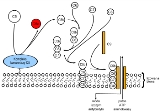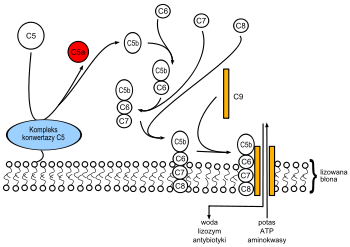
Complement component 5
Encyclopedia
Complement component 5 is a protein
that in humans is encoded by the C5 gene
.
Complement component 5 is involved in the complement system
. It is cleaved into C5a and C5b:
Deficiency is thought to cause Leiner's disease
.
that possesses potent spasmogenic
and chemotactic
activity, is derived from the alpha polypeptide via cleavage with a convertase. The C5b macromolecular cleavage product can form a complex with the C6 complement component
, and this complex is the basis for formation of the membrane attack complex, which includes additional complement components.
.

Protein
Proteins are biochemical compounds consisting of one or more polypeptides typically folded into a globular or fibrous form, facilitating a biological function. A polypeptide is a single linear polymer chain of amino acids bonded together by peptide bonds between the carboxyl and amino groups of...
that in humans is encoded by the C5 gene
Gene
A gene is a molecular unit of heredity of a living organism. It is a name given to some stretches of DNA and RNA that code for a type of protein or for an RNA chain that has a function in the organism. Living beings depend on genes, as they specify all proteins and functional RNA chains...
.
Complement component 5 is involved in the complement system
Complement system
The complement system helps or “complements” the ability of antibodies and phagocytic cells to clear pathogens from an organism. It is part of the immune system called the innate immune system that is not adaptable and does not change over the course of an individual's lifetime...
. It is cleaved into C5a and C5b:
- C5aC5aC5a is a protein fragment released from complement component C5. In humans, the polypeptide contains 74 amino acids. NMR spectroscopy proved that the molecule is composed of four helices and loops connecting the helices. On the N terminus a short 1.5 turn helix is also present. The longest helix...
plays an important role in chemotaxisChemotaxisChemotaxis is the phenomenon in which somatic cells, bacteria, and other single-cell or multicellular organisms direct their movements according to certain chemicals in their environment. This is important for bacteria to find food by swimming towards the highest concentration of food molecules,...
. - C5b forms the first part of the complement membrane attack complexComplement membrane attack complexThe membrane attack complex is typically formed on the surface of intruding pathogenic bacterial cells as a result of the activation of the alternative pathway of the complement system, and it is one of the effector proteins of the immune system. The membrane-attack complex forms transmembrane...
.
Deficiency is thought to cause Leiner's disease
Leiner's disease
Leiner's disease is a systemic disease, a skin disorder and extends to erythroma, typically diagnosed in early infancy. Leiner’s disease is characterized by a long lasting seborrhea dermatitis associated with increased likelihood to infection...
.
Function
Complement component 5 is the fifth component of complement, which plays an important role in inflammatory and cell killing processes. This protein is composed of alpha and beta polypeptide chains that are linked by a disulfide bridge. An activation peptide, C5a, which is an anaphylatoxinAnaphylatoxin
Anaphylatoxins, or anaphylotoxins, are fragments that are produced as part of the activation of the complement system.. Complement components C3, C4 and C5 are large glycoproteins that have important functions in the immune response and host defense...
that possesses potent spasmogenic
Spasm
In medicine a spasm is a sudden, involuntary contraction of a muscle, a group of muscles, or a hollow organ, or a similarly sudden contraction of an orifice. It is sometimes accompanied by a sudden burst of pain, but is usually harmless and ceases after a few minutes...
and chemotactic
Chemotaxis
Chemotaxis is the phenomenon in which somatic cells, bacteria, and other single-cell or multicellular organisms direct their movements according to certain chemicals in their environment. This is important for bacteria to find food by swimming towards the highest concentration of food molecules,...
activity, is derived from the alpha polypeptide via cleavage with a convertase. The C5b macromolecular cleavage product can form a complex with the C6 complement component
Complement component 6
Complement component 6 is a protein that in humans is encoded by the C6 gene.Complement component 6 is a protein involved in the complement system. It is part of the membrane attack complex which can insert into the cell membrane and cause cell to lyse....
, and this complex is the basis for formation of the membrane attack complex, which includes additional complement components.
Clinical significance
Mutations in this gene cause complement component 5 deficiency, a disease where patients show a propensity for severe recurrent infections. Defects in this gene have also been linked to a susceptibility to liver fibrosis and to rheumatoid arthritisRheumatoid arthritis
Rheumatoid arthritis is a chronic, systemic inflammatory disorder that may affect many tissues and organs, but principally attacks synovial joints. The process produces an inflammatory response of the synovium secondary to hyperplasia of synovial cells, excess synovial fluid, and the development...
.
Complement system pathway


